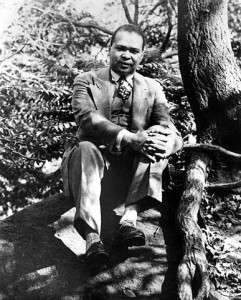Trochees: An African American Tradition
BY Annie Finch

Countee Cullen
In a recent blog for Lemon Hound on Claude McKay, one topic that came up was the importance of the trochaic undercurrent in McKay’s famous sonnet “If We Must Die.” I wrote that the power of this rhythm for McKay is no surprise in the context of African American poetics, since the trochaic meter has been established as a powerful alternative to iambic meter in some centrally influential African American poems of the twentieth century.
Like any meter, trochees can of course be used for any mood or subject. Still, awareness of the history and connotations of trochees as an alternative to the ubiquitous iambic meter can help us appreciate their impact in particular poems. Trochaic meter has long been a meter of choice to convey voices, attitudes, and stories that unsettle the most dominant, conscious culture, whether Poe's raven, Longfellow's Native American culture, or the witches in MacBeth. In the twentieth century, this meter seems to have developed into something of a conscious tradition in African American poetics, at least based on the evidence of two important and culturally ambitious poems, Gwendolyn Brooks' epic "The Anniad" and Countee Cullen's long lyric celebration, "Heritage." Here is a passage from the opening of “The Anniad" :
Think of sweet and chocolate,
Left to folly or to fate,
Whom the higher gods forgot,
Whom the lower gods berate;
Physical and underfed
Fancying on the featherbed
What was never and is not. . .
Trochees have a stereotypical reputation for incantatory simplicity (think of “double, double toil and trouble,” “by the shores of Gitchee Gumee,” and “Tyger, tyger burning bright”). But Brooks infuses great complexity into the meter through variety of diction, from the formal (“berate”) to the idiomatic (“fancying”), and also through a large number of metrical variations. These include the “footless” line (missing a final unstressed syllable, which is true of every line in this brief excerpt) and the substitution of a dactyl FANCYing). She even substitutes an iamb, "and is" in the last line (WHAT was NEVer and IS NOT), respecting the subtle aural convention that, just like substituting a trochee in an iambic line, this usually happens after a ceasura or pause in the grammar, in this case the grammatical pause after "never."
While Brooks’ trochees are characterized by an arch, near-ironic quality, conveying her skeptical embrace of the epic tradition, Cullen’s “Heritage” uses the same meter in a more incantatory way, with lush, innocent sensuality:
What is Africa to me:
Copper sun or scarlet sea,
Jungle star or jungle track,
Strong bronzed men, or regal black
Women from whose loins I sprang
When the birds of Eden sang?
One three centuries removed
From the scenes his fathers loved,
Spicy grove, cinnamon tree,
What is Africa to me?
Cullen’s poem, with its extremely regular trochees compared to Brooks’, has a dignity and, paradoxically for all its lushness, a classicism.
At a time when even the workings of iambic meter are mysterious to most of us, noniambic meters have been flying well under the radar for decades. Looking back at those poets of the twentieth century who did use the noniambic meters (especially trochees, anapests, and dactyls) consciously and skillfully provides a refreshing reminder of the potential of poetic forms to continually refresh and reinvent themselves in new ways.
Annie Finch is a poet, translator, cultural critic, and performance artist. She is the author of seven...
Read Full Biography

